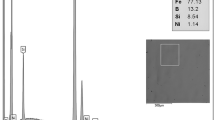Abstract
In this paper, we have studied the effects of the thermomagnetic treatment in a transverse magnetic field (TMaT⊥) on the permeability of the amorphous alloy Co69Fe3.7Cr3.8Si12.5B11 with such a low saturation magnetostriction (λ s 10–7) that, in the ribbons of this alloy rolled into a toroid, a sharp longitudinal magnetic texture is observed (K sq > 0.90). It has been revealed that the permeability μ4 (H = 4 mOe, f = 1 kHz) as a function of the annealing temperature or time of holding at a temperature is described by a curve with a maximum. This maximum is observed at a coefficient of the squareness of the hysteresis loop K sq,m in the range of 0.2 ≤ K sq,m ≤ 0.4. The regimes of the TMaT have been determined that provide optimum values of the permeability μ4 (15000) without a loss of the ductile state of the ribbons of this alloy. Based on the example of an iron-based alloy of composition Fe57Co31Si2.9B9.1 with λs = 35 × 10–6, it has been shown that the formation of the hysteretic magnetic properties upon the TMaT⊥ depends substantially on the magnitude of the magnetostriction and the Curie temperature of the amorphous alloys.
Similar content being viewed by others
References
C. D. Graham, “Magnetic Annealing,” Ch. 13 in Magnetic Properties of Metals and Alloys (Am. Soc. for Metals, Metals Park, Ohio, 1959; Inostrannaya Literatura, Moscow, 1961).
I. B. Kekalo, Processes of Structure Relaxation and Physical Properties of Amorphous Alloys (Izd. Dom MISiS, Moscow, 2016), Vol. 2 [in Russian].
G. W. Rathenau, “Time effects in magnetization,” in Magnetic Properties of Metals and Alloys (Am. Soc. for Metals, Metals Park, Ohio, 1959; Inostrannaya Literatura, Moscow, 1961).
S. Krupika, Physik der Ferrite und der verwandten magnetischen Oxide (Academia, Prague, 1973; Mir, Moscow, 1976).
H. Kronmüler, “The role of two-level systems in amorphous metallic alloys. I. Induced anisotropy in amorphous ferromagnets,” Phys. Status Solidi B, 118, 661–673 (1983).
H. Fujimori, H. Obi, Y. Morita, and S. Ohta, Amorphous Magnetism II (Plenum, New York, 1977).
H. Kronmüler, “Magnetic aftereffects, induced anisotropies, and the role of two-level systems in amorphous alloys,” J. Magn. Magn. Mater. 41, 366–375 (1984).
T. Egami and V. Vitek, “Local structural fluctuations and defects in metallic glass,” J. Non-Cryst. Solids 62, 499–510 (1984).
T. Egami, “Atomic short-range ordering in amorphous metal alloys,” in Amorphous Metallic Alloys (Butterworths Monographs in Materials) (Butterworths, London, 1983; Metallurgiya, Moscow, 1987), pp. 100–113.
I. B. Kekalo, V. L. Stolyarov, V. E. Taranichev, and V. Yu. Tsvetkov, “Formation of magnetic properties of Fe5Co70Si15B10 amorphous alloy upon the thermomagnetic treatment dependingence on its initial state,” Fiz. Met. Metalloved. 55, 484–490 (1983).
V. V. Shulika, I. E. Startseva, A. A. Glazer, and A. P. Potapov, “Dependence of magnetic properties of the Fe71Si7B12 amorphous alloy on the rate of cooling upon thermomagnetic treatment, “ Fiz. Met. Metalloved., No. 3, 192–195 (1990).
I. B. Kekalo and B. A. Samarin, Physical Materials Science of Precision Alloys. Alloys with Specific Magnetic Properties (Metallurgiya, Moscow, 1989) [in Russian].
I. B. Kekalo, A. N. Zhdanov, and V. Yu. Tsvetkov, “Effect of annealing in a transverse magnetic field on the permeability of the Fe5Co70Si15B10 amorphous alloy,” Fiz. Met. Metalloved. 57, 1213–1215 (1984).
H. Sakakima, H. Senno, Y. Yanagiuchi, and E. Hirota, “Zero magnetostrictive amorphous alloys with high permeability and high magnetic induction,” J. Appl. Phys. 52, 2480–2482 (1981).
T. Jagielinski, “Elimination of disaccommodation in zero-magnetostrictive FeCoSiB amorphous alloys,” J. Appl. Phys. 53, 7852–7854 (1982).
I. B. Kekalo, V. A. Klycheva, and V. E. Taranichev, “Formation of magnetic properties of toroid-like samples of the Co77Cr12Zr11 amorphous alloy with very small magnetostriction,” Fiz. Met. Metalloved. 67, 700–707 (1989).
V. Yu. Vvedenskii and I. B. Kekalo, “Theoretical study of magnetic-anisotropy effects on initial permeability of amorphous alloys with near–zero magnetostriction,” Phys. Met. Metallogr. 81, 49–56 (1996).
K. Shirae, “Compatibility of dc and ac magnetic properties of amorphous magnetic materials,” J. Appl. Phys. 50, 7618–7620 (1979).
K. Narita, J. Yamasaki, and H. Hukunaga, “Measurement of saturation magnetostriction of a thin amorphous ribbon by means of small-angle magnetization rotation,” IEEE Trans. Magn. 16, 435–439 (1980).
I. B. Kekalo, L. Z. Lubyanyi, P. S. Mogil’nikov, and I. A. Chichibaba, “Processes of structural relaxation in the Co69Fe3.7Sr3.8Si12.5B11 amorphous alloy with a near-zero magnetostriction and their effect on the magnetic properties and the characteristics of magnetic noise caused by Barkhausen jumps,” Phys. Met. Metallogr. 116, 645–655 (2015).
I. B. Kekalo, Processes of Structural Relaxation and Physical Properties of Amorphous Alloys (Izd. Dom MISiS, Moscow, 2014), Vol. 1 [in Russian].
I. B. Kekalo, O. V. Basargin, and V. Yu. Tsvetkov, “Dilatometric analysis of structural relaxation processes in amorphous alloys,” Fiz. Met. Metalloved. 57, 967–974 (1984).
B. S. Bokshtein, L. M. Kaputkina, G. Kovachev, Yu. B. Levin, and G. S. Nikol’skii, “Kinetics of release of excess volume in amorphous cobalt-based alloys,” Fiz. Met. Metalloved. 72, 75–79 (1991).
I. B. Kekalo, Atomic Structure of Amorphous Alloys and Its Evolution (Izd. Ucheba, MISiS, Moscow, 2006) [in Russian].
K. Hayashi, M. Hayakawa, Y. Ochiai, H. Matsuda, W. Ishikawa, and K. Aso, “Stress-induced anisotropy and permeability of magnetostrictive Co-based amorphous alloys,” J. Appl. Phys. 55, 3028–3032 (1984).
V. Yu. Vvedenskii and I. B. Kekalo, “The effect of magnetic anisotropy on the rectangularity of the hysteresis loop of amorphous alloys,” Phys. Met. Metallogr., 73, 303–400 (1992).
Author information
Authors and Affiliations
Corresponding author
Additional information
Original Russian Text © I.B. Kekalo, P.S. Mogil’nikov, 2016, published in Fizika Metallov i Metallovedenie, 2016, Vol. 117, No. 6, pp. 551–561.
Rights and permissions
About this article
Cite this article
Kekalo, I.B., Mogil’nikov, P.S. The formation of hysteretic magnetic properties in amorphous alloys of various classes upon thermomagmetic treatment in a transverse magnetic field. Phys. Metals Metallogr. 117, 529–539 (2016). https://doi.org/10.1134/S0031918X16060041
Received:
Accepted:
Published:
Issue Date:
DOI: https://doi.org/10.1134/S0031918X16060041



